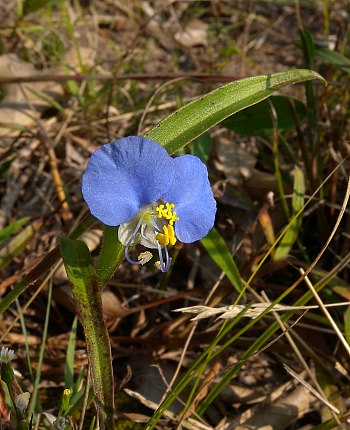Description: This perennial wildflower is ½–2' tall and either unbranched or sparingly branched. The central stem is green, glabrous to pubescent (usually the latter), terete, erect, and rather succulent. A few alternate leaves occur along the length of the central stem (and any lateral stems); they are widely spreading and slightly recurved. The leaf blades are 2-6" long and ¼–1" across; they are medium green, glabrous (or nearly so), slightly fleshy, linear to lanceolate in shape, parallel-veined, and smooth along their margins. The base of each leaf blade is sessile, or it has short petiole. Each leaf has a closed sheath about ½" long. The upper margin of each sheath is rolled outward, above which there is a tuft of long hairs. There are both axillary and terminal flowers. The flowers usually occur individually, less often in cymes of 2-3.

Each flower spans
¾–1¼" across, consisting of 2 large blue petals (above), 1 small white
petal (below), 3 light green sepals, a pistil with a single slender
style, and 6 stamens. The petals are well-rounded, but become very
narrow at the base. There are 3 kinds of stamens: 3 sterile stamens
with cross-shaped pseudo-anthers that are bright yellow, 1 central food
stamen with a bright yellow butterfly-shaped anther, and 2 lateral
stamens with gray or purple anthers. The sterile stamens (staminodia)
are located a little above and behind the food stamen. The pollen of
both the food stamen and lateral stamens are yellow. Below each flower,
there is a keeled green spathe that resembles the hull of a boat. The
upper edges of the spathe are rounded, while the folded edge below is
flat and ciliate. The upper edges of the spathe are joined together at
the base (behind the flower) for about one-third the length of the
spathe, otherwise they are open. Each folded spathe is ½–1½" long and
about one-half as much tall. The blooming period occurs from mid-summer
to early fall and lasts about 2 months. Each flower remains open for a
few hours during the morning, after which it closes. There is no
noticeable floral scent. The flowers are capable of self-pollination.
Each flower is replaced by a 3-celled seed capsule; each cell of the
capsule contains a single seed. Individual seeds are about 1/8" long,
brown, and smooth. The root system consists of fleshy fibrous roots.
This wildflower reproduces by reseeding itself.
Cultivation:
The preference is partial to full sun, mesic to dry conditions, and
sandy or rocky soil.

Range & Habitat:
The native Slender Dayflower is occasional in the western half of
Illinois, NE
Illinois, and southern Illinois, otherwise it is absent (see Distribution
Map). Habitats include dry sand prairies, sand dunes, upland
sandy woodlands, upland rocky woodlands, sandy savannas, thinly wooded
bluffs and cliffs, rocky glades, sandy areas along railroads, and areas
along sandy paths. Slender Dayflower benefits from occasional wildfires
as this reduces the encroachment of woody vegetation. Generally, plants
with more slender leaves (var. angustifolia and var.
deamii) are more common in prairies than the typical variety.
Faunal Associations:
The flowers are pollinated by various long-tongued bees, which collect
pollen from the food stamen. No nectar is provided as a floral reward.
A group of several leaf beetles (Chrysomelidae) are known to feed on
Slender Dayflower; the larvae typically bore through the stems, while
the adults occasionally feed on the leaves. These leaf beetle species
include: Neolema jacobina, Neolema
quadriguttata, Oulema cornuta, Oulema
elongata, and Oulema simulans. The seeds
of Commelina spp. (Dayflowers) are eaten by the
Bobwhite and Mourning Dove, while the foliage is occasionally browsed
by White-Tailed Deer, domestic cattle, and similar hoofed mammalian
herbivores.
Photographic Location:
A sandy path at Hooper Branch Savanna Nature Preserve in Iroquois
County, Illinois. The photographed plant is probably Commelina
erecta var. deamii.
Comments:
Both the flowers and foliage are ornamental. The "true blue" color of
the upper petals is very rare among wildflowers. The flowers of Slender
Dayflower are very similar to those of the introduced Commelina
communis (Asiatic Dayflower). It differs from the latter
species by its more erect stems, more slender leaves, and the joined
upper margins at the base of its spathes. The Asiatic Dayflower can
form rootlets at its nodes, thereby establishing vegetative colonies,
and its seeds are irregular and wrinkled. Slender Dayflower, in
contrast, does not form rootlets at its nodes and its seeds are smooth.
Slender Dayflower is a highly variable species, and three different
varieties have been described for Illinois: 1) var. erecta
has wide leaves (¾" or more) and large spathes (¾–1½" long), 2) var.
angustifolia has narrow leaves (less than ¾" across) and
small spathes (less than ¾" long), and 3) var. deamii
has narrow leaves (less than ¾" across) and large spathes (¾–1½" long).
Because these three varieties can intergrade, some field specimens may
be difficult to classify.